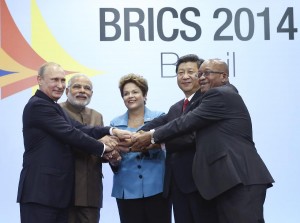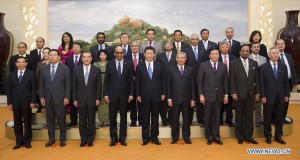China’s Multilateral Banks
I last posted last week on China’s frustrations with the current structure and lack of reform at US-led multilateral financial institutions, namely, the World Bank (WB), the International Monetary Fund (IMF), and the Asian Development Bank (ADB).
China’s deep dissatisfaction has lead to the formation, all within a year, of similar institutions, albeit on a smaller scale: the BRICS New development Bank (NDB), the Asian Infrastructure Investment Bank (AIIB), and a fund for projects along the land-based and maritime Silk Roads. All three institutions/funds are geared toward solving infrastructure and transport bottlenecks across Eurasia and a number of sub- regions.
Formed last July, the NDB, with initial capital of US$50 billion that will steadily increase to $100 billion, will be headquartered in Shanghai and authorized to lend up to $34 billion a year. The five BRICS countries will contribute $10 billion each toward initial capitalization, the first president will be an Indian, and South Africa will be the African headquarters of the bank. But, most important, in a break with WB structure which assigns votes according to capital share, each participant country is assigned one vote and no country holds veto power.
Created along with the NDB is the US$100 billion Contingent Reserve Arrangement (CRA) designed to provide protection against global liquidity pressures as well as assistance to non-BRICS countries facing severe monetary crises. Each member will contribute $2 billion toward “paid-in capital” but China will pump in the lion’s share ($41 billion) of the initial capital of $100 billion with Brazil, Russia, and India each giving $18 billion and South Africa taking up the rear with $5 billion. Slated to start lending in 2016, it is essentially an attempt by the BRICS to soften their dependence on the US Federal Reserve and the dominance of the US dollar.
Barry Eichengreen, a prominent political economist at the University of California, Berkeley, wrote in the Project Syndicate last summer the NDB makes a lot of sense for the BRICS and has a good chance of survival, especially given the critical need for infrastructure and other investment across the BRICS. However, the CRA is another matter. Faced with a BRICS country experiencing a major crisis, such as Russia right now with its plummeting ruble, to draw largely on the fund, the other BRICS would most certainly balk at lending large sums to that country, Prof. Eichengreen suggested.
In addition, it would be hard to impose conditionalities on such a large and proud country as Mother Russia. And attempts to establish swap lines and credits such as under the Chiang Mai Initiative in the wake of the 1997 Asian Financial Crisis, would be equally hard to implement. In this connection, it is a stroke of luck for the NDB that the ruble took a nose dive at this point in global monetary history as opposed to post 2016 when the NDB actually starts lending. In any case, the ruble debacle shines a big red light on management and lending prudence of the NDB.
As with the NDB, the AIIB was initially brought up by China’s President Xi Jinping a little over a year ago, in large part due to the country’s discontent with existing institutions. In terms of Asia’s developmental needs, the ADB itself estimates a whopping US$8 trillion is needed for national infrastructures and another $290 billion for regional infrastructure through 2020 to sustain Asia’s growth. Currently, the ADB finances less than 2% of Asia’s needs so any help the AIIB can provide would be greatly welcomed across the continent.
Last June, China proposed a doubling of registered capital to US$100 billion and asked India to join as a founding member. Eventually, 21 countries, including staunch US allies like the Philippines, signed on to the founding document with Australia and South Korea demurring due to US pressure. A little while later, following a visit by Chinese Foreign Minister Wang Yi, Indonesia, the largest economy in ASEAN, decided to get on board. Australia indicated it would still be interested in joining if certain transparency and governance issues were addressed as did South Korea. The next step is to negotiate the bank’s articles of agreement, expected to be completed by the end of next year.
WB President Jim Yong Kim said he welcomed the activities of new organizations like the AIIB because of Asia’s pressing needs and ADB President Takehiko Nakao said his bank is prepared to work with the AIIB. Not surprisingly, the big party-pooper remaining is the Obama Administration’s State Department which questioned the banks’ standards based on safeguards and accountability issues. Kenneth Lieberthal, a renowned China expert at the Brookings Institution and former advisor to President Bill Clinton recommended strongly for the US to get involved or risk appearing intransigent.
Speaking to the VOA, he counseled, “I think we actually ought to get engaged with this, becoming a part of it, and try to, through that engagement, both show the Chinese that we are prepared to accept a greater role for them in areas where they are contributing to public goods and we want to work with them to have the standards that are necessary to sustain the way the international system now functions.”
Similarly at the behest of President Xi, in November, China announced a fund to finance infrastructure projects along both land-based and maritime Silk Road routes. Capitalized at $16.3 billion to gradually expand to $50 billion without a cap, the fund will be backed by the People’s Bank of China (China’s central bank), the Ministry of Finance, and the country’s development banks. More than half of the fund will come from China’s foreign exchange reserves which at last count had topped $3.88 trillion. Financing will be limited to Central Asia, the Middle East, South Asia, Southeast Asia, and southeast and eastern Europe. Xi has asked for the expedition of a detailed timetable, road map, and list of initial projects.
Finally, last May, a public-private consortium involving the city of Fuzhou in east coast Fujian province, the Fujian branch of the China Development Bank, and the China-Africa Development (private equity) Fund (CAD Fund) signed a MOU to set up a $1.6 billion fund to support such projects as marine aquaculture farms and industrial parks in ASEAN countries as part of development along the traditional maritime Silk Road route stretching through the Strait of Malacca to the Horn of Africa and eventually to the Red Sea and Mediterranean.
In setting up these institutions and funds, China has morphed from importer of capital to major exporter geared toward the massive building of infrastructure across Asia and the world.



0 Comments
Trackbacks/Pingbacks